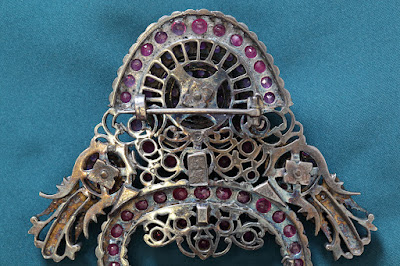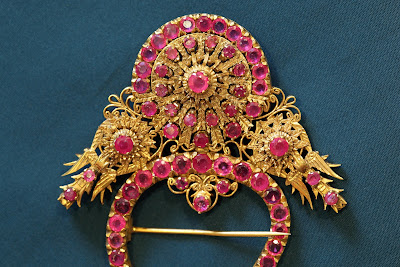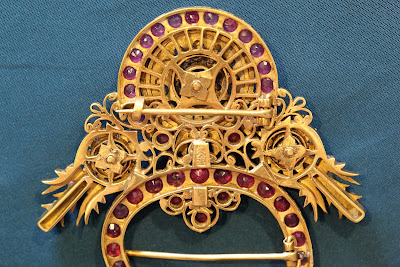From my research, there are several names for this unique item. Kerongsang or kerongsang serong or brooches or kerongsang rantai (if it's linked with chains to each brooch) was first favoured by the Penang Peranakans, but its use gradually spread to Malacca and Singapore. It is usually worn with a baju panjang. The kerongsang serong consists of a large paisley-shaped piece or kerongsang ibu (mother) that is teamed with two smaller brooches, each called the kerongsang anak (child), or kerongsang bulat (round), if they were round in shape.
Most of the diamonds found in old Peranakan jewellery are believed to have come from Banjarmasin in Southern Kalimantan, which have the only mines in the region. These intan or diamonds were typically of a yellow hue, described as warna air chempaka or "the aqueous hue of the chempaka flower". The diamonds would usually be rose-cut (hand cut) with a flat back and domed and faceted face. They were known as intan minyak. By the late 19th century, brilliant cut diamonds began to appear. These new brilliant cut diamonds or berlian have a pointed back, reflecting light entering the top of the gems and back out again, giving the sparkling effect we associate with cut diamonds today.
Here are shown a few sets of my kerongsang collection.
 Kerongsang with ibu and anak 1.
Kerongsang with ibu and anak 1.
-Front- -Back-
-Back- Closer look of the workmanship.
Closer look of the workmanship.
-Front- Closer look of the workmanship.
Closer look of the workmanship.
-Back- The mark at the back of the ibu kerongsang which is in Chinese character "紋銀", meaning "fine silver".
The mark at the back of the ibu kerongsang which is in Chinese character "紋銀", meaning "fine silver". Kerongsang with ibu and anak 2.
Kerongsang with ibu and anak 2.
-Front- -Back-
-Back- Closer look of the workmanship.
Closer look of the workmanship.
-Front- Closer look of the workmanship.
Closer look of the workmanship.
-Back- The mark at the back of the ibu kerongsang which is in Chinese character "紋銀", meaning "fine silver".
The mark at the back of the ibu kerongsang which is in Chinese character "紋銀", meaning "fine silver". Kerongsang with ibu and anak 3.
Kerongsang with ibu and anak 3.
-Front- -Back-
-Back- Closer look of the workmanship.
Closer look of the workmanship.
-Front- Closer look of the workmanship.
Closer look of the workmanship.
-Back- The mark at the back of the ibu kerongsang which is in Chinese character "久金", meaning "old gold".
The mark at the back of the ibu kerongsang which is in Chinese character "久金", meaning "old gold". Kerongsang with ibu and anak 4.
Kerongsang with ibu and anak 4.
-Front- -Back-
-Back- Kerongsang with ibu and anak 5.
Kerongsang with ibu and anak 5.
-Front- -Back-
-Back- Kerongsang with ibu and anak 6.
Kerongsang with ibu and anak 6.
-Front- -Back-
-Back- Kerongsang bulat 7.
Kerongsang bulat 7.
-Front- -Back-
-Back- Kerongsang Rantai with dragonflies 8.
Kerongsang Rantai with dragonflies 8. -Front-
-Front- -Back-
-Back- Closer look of the workmanship.
Closer look of the workmanship. Kerongsang rantai Melayu 9.
Kerongsang rantai Melayu 9. The detail of the workmanship.
The detail of the workmanship. The detail of the workmanship.
The detail of the workmanship. Kerongsang rantai 10.
Kerongsang rantai 10. Kerongsang rantai 11.
Kerongsang rantai 11. Kerongsang rantai 12.
Kerongsang rantai 12. Kerongsang rantai 13.
Kerongsang rantai 13.
(With the rantai or chain missing). Incomplete and broken ibu kerongsang.
Incomplete and broken ibu kerongsang.
-Front- -Back-
-Back- The detail of the silversmith work.
The detail of the silversmith work. The same incomplete and broken ibu kerongsang with also broken anak kerongsang.
The same incomplete and broken ibu kerongsang with also broken anak kerongsang.
-Front- -Back-
-Back-The reason I bought this incomplete and broken ibu kerongsang from an antique dealer in Malacca is due to its uniqueness and the detail of the silversmith work which is very hard to find elsewhere.
 Incomplete set of kerongsang, which only with one of the anak kerongsang.
Incomplete set of kerongsang, which only with one of the anak kerongsang.
-Front- -Back-
-Back- Incomplete set of kerongsang, which only with one of the anak kerongsang.
Incomplete set of kerongsang, which only with one of the anak kerongsang. Incomplete set of kerongsang, which only with one of the anak kerongsang.
Incomplete set of kerongsang, which only with one of the anak kerongsang. The mark at the back of the ibu kerongsang which is in Chinese character "紋銀", meaning "fine silver".
The mark at the back of the ibu kerongsang which is in Chinese character "紋銀", meaning "fine silver". The mark at the back of the ibu kerongsang which is in Chinese character "紋銀", meaning "fine silver".
The mark at the back of the ibu kerongsang which is in Chinese character "紋銀", meaning "fine silver".



































